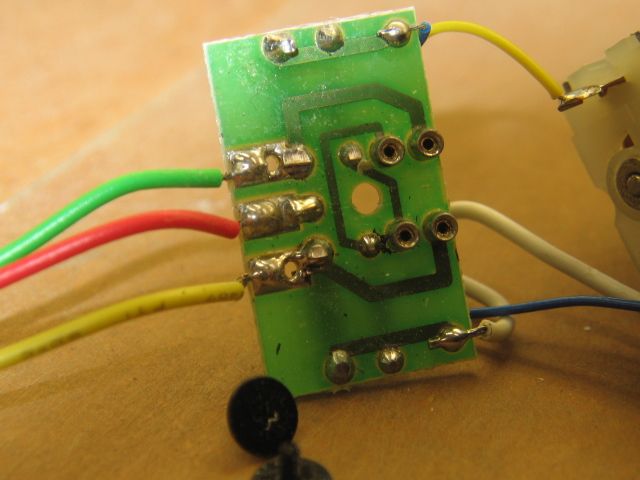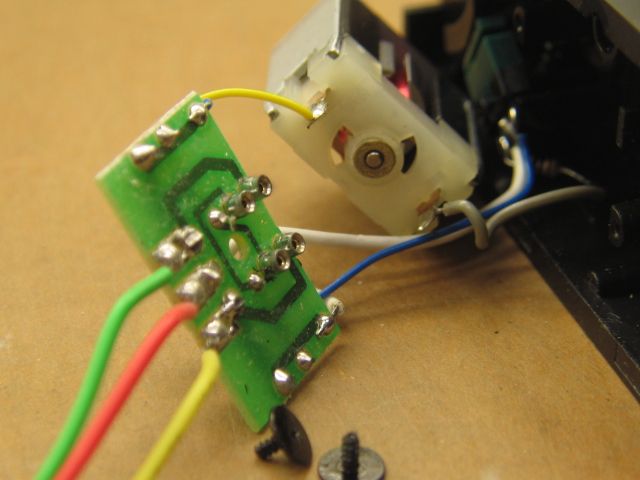Has anyone ever had one of the three wires for the DZ 1000 switch motors break off?
Replies sorted oldest to newest
Yes. this week. I tried to solder it back with a thin tip solder pencil. It worked but I melted the plastic. I tried to take it apart but to get the board out is not easy so I gave up. Wires are fragile. I have been powering up my DZ1000 this week and it is labor intensive. Between the wires and hook up and tweaking the switches it has been a PIA.
I like the DZ-1000's, but they do need a little more substantial wire on them. Not only fragile, but hard to see, strip and connect to anything. Going to a #20 or #22 wire can't add that much to the cost, at least I wouldn't think it would? Haven't broken one yet, but I imagine it will happen someday.
I sent my DZ1000's back to Z-Stuff to have the wire(s) reattached. I forget the cost, but no where near what the cost would had been to replace with new ones.
If you get it apart. This is what you are looking at. Not a real hard solder job. It may be easier just to send them back.


Bottom cover plate off, the two big flat head screws allow for the motor to be removed. Motor out of the way, there is one screw in the PC board. Probably best to re-solder all three wires. Note the Red and Green were re-soldered in the first picture, The yellow is about to fall off. Yellow also needs re-soldered.

rtr, I'm guessing that a heavier wire would put more strain on the solder joint. The #28 being used is very flexible.
I have found that on the controllers, it is easy to take them apart. I'm installing a few dozen, and on some I have to switch the red & green LEDs. I take them apart, and the wires joints are them readily accessible. I find that the LEDs on the motors are easy to switch.
Well there is flexible wire in #20 & #22 awg as well. As for the LED's on the switch machine maybe mine are newer, but the LED's just pull out (straight up) and you can swap them without taking them apart.
The problem is that the end of the wire, Red, Green, Yellow, needs to be tinned so that the solder sucks-back into the small strands inside the insulation. The current install, the tinned wire is only the end of the small wire, so the wire easily breaks at the end of the insulation. As always, IMO. ![]() Mike CT
Mike CT![]() Not sure why you just can't use the wire that fell-off.
Not sure why you just can't use the wire that fell-off.
I also had the 28 ga. wires work loose from the solder points on the switch motors. I used 22 ga. stranded copper wire, tined, and resoldered to the board. Worked fine. I agree, the 28 ga. wires are way to flimsy to work with. I have numerous spare switch machines and push buttons, every time I go to York I take a bag full of defective ones, with my card inside and give to Dennis. He repairs them and sends them back. Be careful with the LED's - they are polarity sensitive, one side is flat, if it does not work, swap the ends. I use a pair of straight pliers to pull them, a small needle nose simply can not grasp the led.
Bruce, I have found that I can pull the LEDs from the switch motors with my fingers, but it's almost impossible to pull them from controllers.
I think I found an easy fix for the broken wires on the DZ 1000. A #3 metric screw self threads into the hole where the wire is soldered. I purchased some 1" screws and cut them into short set screws slotted with the dremel tool. Tin the ends ow the new wire, insert and tighten set screw. do not over tighten or you will crack the circuit board. I took one apart and had a tough time with it.
Attachments
DZ1000's & controllers used to have screws. They were a real headache and I'm happy Z-Stuff has gotten away from them. It was a reason why I resisted using Z-1000's for years.
To follow up on my earlier post, I tried a few possible remedies.
I had the same problems as others. It worked, did not work, one side worked, etc. My first effort was to test the switch machine unhooked to the turnout. I found that they all worked to various degrees. So my next step was to add a little graphite.
Next I moved the turnout without being attached to the switch machine. Some were ok but others had some drag due to the ties or rails. I lubricated the bar under the rail and scrapped away some of the wooden ties to get an unencumbered movement.
After that, I positioned the switch machine, by hand, trying to get the the optimum movement and position. Once I was satisfied, I put one screw to hold the switch machine. Some worked and others did not. I moved one machine a quarter of an inch away from the ties and another I had to put a small shim under the back end of the machine.
I have seven working so far in the yard and four over one section of the main line. Only twenty more to go.
Good luck everyone.








